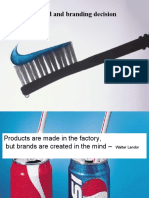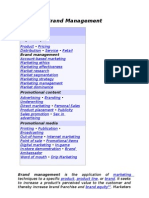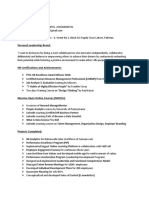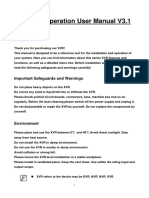0 ratings0% found this document useful (0 votes)
34 viewsGuinness World Records: Golden Syrup
Bass & Company established pioneering brand marketing techniques in the late 18th century, becoming one of the earliest global brands. In the 19th century, mass production led to widespread branding on packaged goods to differentiate them and build trust with consumers. By the late 19th century, manufacturers recognized that attaching personalities to brands through branding and advertising helped products outsell rivals. This established modern branding practices where consumers buy brands instead of just products.
Uploaded by
Gabi IonitaCopyright
© © All Rights Reserved
Available Formats
Download as DOCX, PDF, TXT or read online on Scribd
0 ratings0% found this document useful (0 votes)
34 viewsGuinness World Records: Golden Syrup
Bass & Company established pioneering brand marketing techniques in the late 18th century, becoming one of the earliest global brands. In the 19th century, mass production led to widespread branding on packaged goods to differentiate them and build trust with consumers. By the late 19th century, manufacturers recognized that attaching personalities to brands through branding and advertising helped products outsell rivals. This established modern branding practices where consumers buy brands instead of just products.
Uploaded by
Gabi IonitaCopyright
© © All Rights Reserved
Available Formats
Download as DOCX, PDF, TXT or read online on Scribd
You are on page 1/ 2
Some brands still in existence as of 2018
date from the 17th, 18th and 19th centuries' period of
mass-production. Bass & Company, the British brewery founded in 1777, became a pioneer in
international brand marketing. Many years before 1855 Bass applied a red triangle to casks of its
Pale Ale. In 1876 its red-triangle brand became the first registered trademark issued by the
British government.[48] Guinness World Records recognizes Tate & Lyle (of Lyle's Golden Syrup)
as Britain's, and the world's, oldest branding and packaging, with its green-and-gold packaging
having remained almost unchanged since 1885. [49] Twinings Tea has used the same logo —
capitalized font beneath a lion crest — since 1787, making it the world's oldest in continuous use.
[50][51]
A tin of Lyle's Golden Syrup, first sold in London in 1885. Recognised by Guinness World Records as
having the world's oldest branding and packaging. [52]
A characteristic feature of 19th-century mass-marketing was the widespread use of branding,
originating with the advent of packaged goods.[14] Industrialization moved the production of many
household items, such as soap, from local communities to centralized factories. When shipping
their items, the factories would literally brand their logo or company insignia on the barrels used,
effectively using a corporate trademark as a quasi-brand. [53]
Factories established following the Industrial Revolution introduced mass-produced goods and
needed to sell their products to a wider market – that is, to customers previously familiar only
with locally produced goods.[54] It became apparent that a generic package of soap had difficulty
competing with familiar, local products. Packaged-goods manufacturers needed to convince the
market that the public could place just as much trust in the non-local product. Gradually,
manufacturers began using personal identifiers to differentiate their goods from generic products
on the market. Marketers generally began to realize that brands, to which personalities were
attached, outsold rival brands.[55] By the 1880s large manufacturers had learned to imbue their
brands' identity with personality traits such as youthfulness, fun, sex appeal, luxury or the "cool"
factor. This began the modern practice now known as branding, where the consumers buy the
brand instead of the product and rely on the brand name instead of a retailer's recommendation.
The process of giving a brand "human" characteristics represented, at least in part, a response to
consumer concerns about mass-produced goods.[56] The Quaker Oats Company began using the
image of the Quaker man in place of a trademark from the late 1870s, with great success.
[57]
Pears' soap, Campbell's soup, Coca-Cola, Juicy Fruit chewing gum and Aunt Jemima pancake
mix were also among the first products to be "branded" in an effort to increase the consumer's
familiarity with the product's merits. Other brands which date from that era, such as Uncle
Ben's rice and Kellogg's breakfast cereal, furnish illustrations of the trend.
The Quaker Company was one of the earliest to use a character on its packaging, branding, and
advertising. Pictured: The Quaker Man, c. 1900
By the early 1900s, trade-press publications, advertising agencies and advertising experts began
producing books and pamphlets exhorting manufacturers to bypass retailers and to advertise
directly to consumers with strongly branded messages. Around 1900, advertising guru James
Walter Thompson published a housing advertisement explaining trademark advertising. This was
an early commercial explanation of what scholars now recognize as modern branding and the
beginnings of brand management.[58] This trend continued to the 1980s, and as of 2018 is
quantified in concepts such as brand value and brand equity.[citation needed] Naomi Klein has described
this development as "brand equity mania". [59] In 1988, for example, Philip
Morris purchased Kraft for six times what the company was worth on paper. Business analysts
reported that what they really purchased was the brand name.
With the rise of mass media in the early 20th century, companies adopted techniques that
allowed their messages to stand out. Slogans, mascots, and jingles began to appear on radio in
the 1920s and in early television broadcasting in the 1930s. Soap manufacturers sponsored
many of the earliest radio-drama series, and the genre became known as soap opera.[60]
By the 1940s manufacturers began to recognize the way in which consumers had started to
develop relationships with their brands in a social/psychological/anthropological sense.
[61]
Advertisers began to use motivational research and consumer research to gather insights into
consumer purchasing. Strong branded campaigns for Chrysler and Exxon/Esso, using insights
drawn from research into psychology and cultural anthropology, led to some of the most enduring
campaigns of the 20th-century.[62] Brand advertisers began to imbue goods and services with a
personality, based on the insight that consumers searched for brands with personalities that
matched their own.[63]
You might also like
- Creating Poweful Integrating Brand Solutions - Robin LandaNo ratings yetCreating Poweful Integrating Brand Solutions - Robin Landa14 pages
- Oracle - Building A Banking Customer Relationship Data Warehouse - A Case Study - White Paper PDFNo ratings yetOracle - Building A Banking Customer Relationship Data Warehouse - A Case Study - White Paper PDF10 pages
- App-16.2 - Risk Assessment For Traffic Signal System100% (2)App-16.2 - Risk Assessment For Traffic Signal System13 pages
- Trade-Press Advertising Agencies Experts James Walter Thompson TrademarkNo ratings yetTrade-Press Advertising Agencies Experts James Walter Thompson Trademark1 page
- BRANDS UNIT 1 A Brief History of BrandingNo ratings yetBRANDS UNIT 1 A Brief History of Branding5 pages
- Effect of Branding On Consumer Buying BehaviorNo ratings yetEffect of Branding On Consumer Buying Behavior60 pages
- Brand and Brand Management - IntroductionNo ratings yetBrand and Brand Management - Introduction237 pages
- Marketing - ABM11 - Module1 - WEEK7 and 8No ratings yetMarketing - ABM11 - Module1 - WEEK7 and 815 pages
- Brand Image, Is A Symbolic Construct Created Within The Minds of People and Consists ofNo ratings yetBrand Image, Is A Symbolic Construct Created Within The Minds of People and Consists of9 pages
- Brand Elements: Brand Is The "Name, Term, Design, Symbol, or Any Other Feature That Identifies One Seller's Good orNo ratings yetBrand Elements: Brand Is The "Name, Term, Design, Symbol, or Any Other Feature That Identifies One Seller's Good or2 pages
- Brands and Brand Management: Chapter - 2No ratings yetBrands and Brand Management: Chapter - 238 pages
- Chapter Three Introduction To Brand and Brand ManagementNo ratings yetChapter Three Introduction To Brand and Brand Management15 pages
- Bangladesh University of Business and Technology (BUBT) : AssignmentNo ratings yetBangladesh University of Business and Technology (BUBT) : Assignment24 pages
- Project On Effect of Branding On Consumer Buying Decision20% (5)Project On Effect of Branding On Consumer Buying Decision15 pages
- Chapter Five Choosing Brand Element To Build Strong Brand: Elements That Come in Many Different FormsNo ratings yetChapter Five Choosing Brand Element To Build Strong Brand: Elements That Come in Many Different Forms7 pages
- Brand Elements 2. Choosing Brand Elements To Create Brand EquityNo ratings yetBrand Elements 2. Choosing Brand Elements To Create Brand Equity20 pages
- A Secret History of Brands: The Dark and Twisted Beginnings of the Brand Names We Know and LoveFrom EverandA Secret History of Brands: The Dark and Twisted Beginnings of the Brand Names We Know and Love4/5 (11)
- Nature and Science: Other Uses in Arts, Entertainment, and MediaNo ratings yetNature and Science: Other Uses in Arts, Entertainment, and Media2 pages
- Different Accents Within The Regions United States Canada English Scottish Irish British IslesNo ratings yetDifferent Accents Within The Regions United States Canada English Scottish Irish British Isles1 page
- Common Generic Uses: Fall May Also Refer ToNo ratings yetCommon Generic Uses: Fall May Also Refer To2 pages
- Grila TV (Cablu Digital) : Modificare Modificare SursăNo ratings yetGrila TV (Cablu Digital) : Modificare Modificare Sursă2 pages
- Diaper Gasoline Nappy Petrol: AmericanismsNo ratings yetDiaper Gasoline Nappy Petrol: Americanisms1 page
- Orth American English (Name, Nae) Is The Most GeneralizedNo ratings yetOrth American English (Name, Nae) Is The Most Generalized1 page
- Etymology: Etruscan Romans Latin Old French Modern French MedievalNo ratings yetEtymology: Etruscan Romans Latin Old French Modern French Medieval1 page
- North America September Equinox Winter Solstice Labor Day Change Color Solar Term Ireland Met Éireann Irish Calendar GaelicNo ratings yetNorth America September Equinox Winter Solstice Labor Day Change Color Solar Term Ireland Met Éireann Irish Calendar Gaelic1 page
- Comptia CTT+: Candidate Handbook of InformationNo ratings yetComptia CTT+: Candidate Handbook of Information36 pages
- Inchara Priyadarshini S Sushant School of Art and Architecture +91 9686376808No ratings yetInchara Priyadarshini S Sushant School of Art and Architecture +91 96863768084 pages
- A Critical Study On Punishment With Reference To Section 302 of IPCNo ratings yetA Critical Study On Punishment With Reference To Section 302 of IPC16 pages
- b325 ~ حل واجب b325 ** 00966597837185 ~المهندس أحمد~ حلول,واجبات,الجامعة,العربية,المفتوحةNo ratings yetb325 ~ حل واجب b325 ** 00966597837185 ~المهندس أحمد~ حلول,واجبات,الجامعة,العربية,المفتوحة14 pages
- Automatic Vehicle Location (AVL) : UMA. S (2009249007) M.Tech, Remote SensingNo ratings yetAutomatic Vehicle Location (AVL) : UMA. S (2009249007) M.Tech, Remote Sensing29 pages
- Participation of Grade 8 Students in Performing Science Investigatory Project of Maabud National High SchoolNo ratings yetParticipation of Grade 8 Students in Performing Science Investigatory Project of Maabud National High School10 pages
- Regulatory Risk: HSBC Technology and ServicesNo ratings yetRegulatory Risk: HSBC Technology and Services10 pages
- The Problems and Prospects of Corporate Social Responsibility in The Nigerian Manufacturing IndustryNo ratings yetThe Problems and Prospects of Corporate Social Responsibility in The Nigerian Manufacturing Industry81 pages
- Addressing Myanmar S Citizenship CrisisNo ratings yetAddressing Myanmar S Citizenship Crisis19 pages
- Adapting To Change in A Changing Business EnvironmentNo ratings yetAdapting To Change in A Changing Business Environment10 pages








































































































